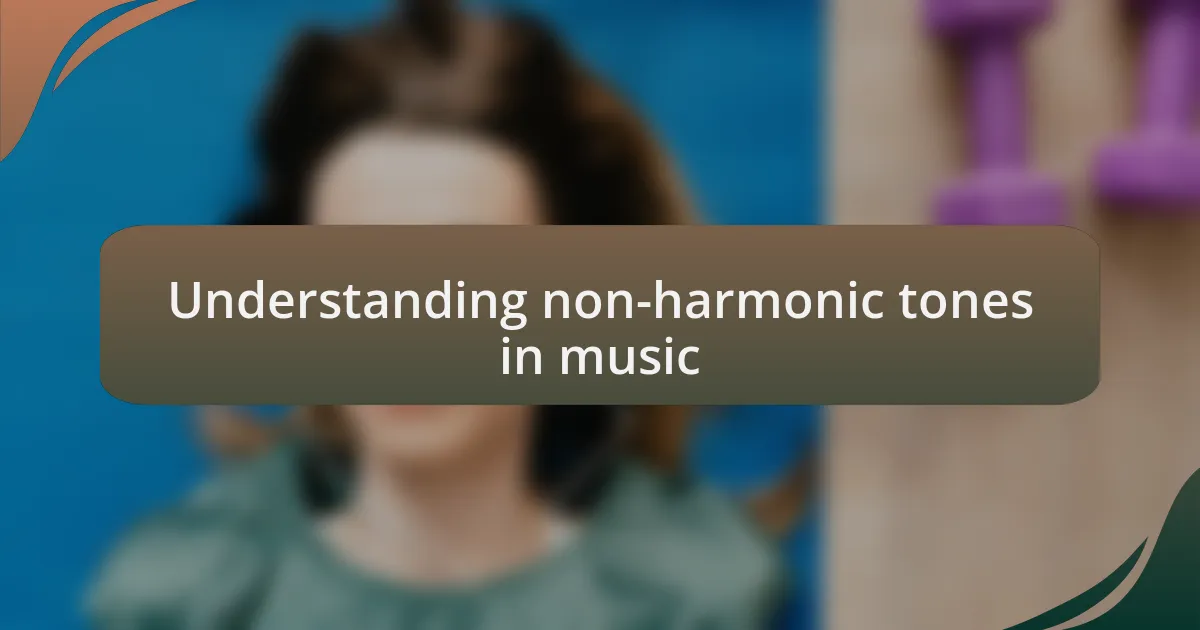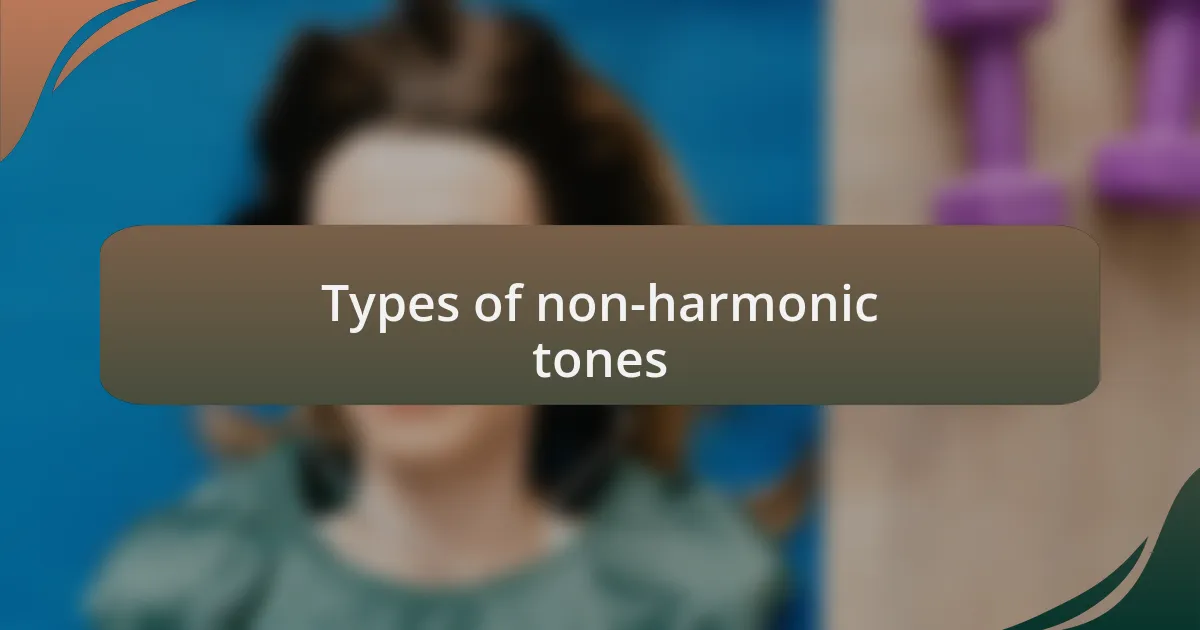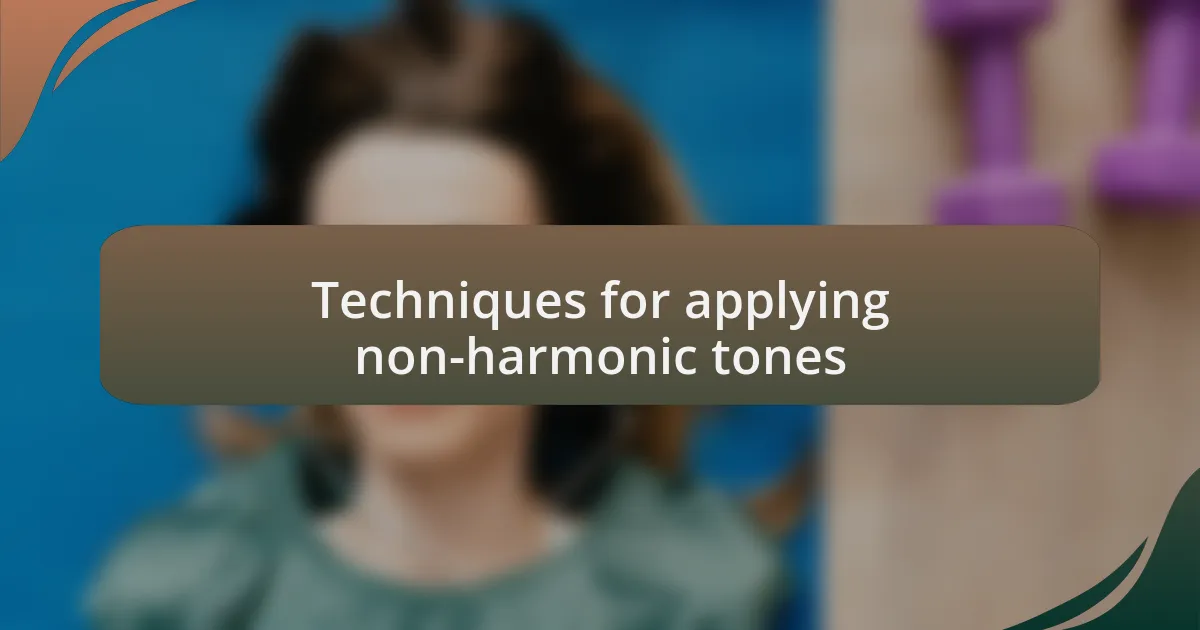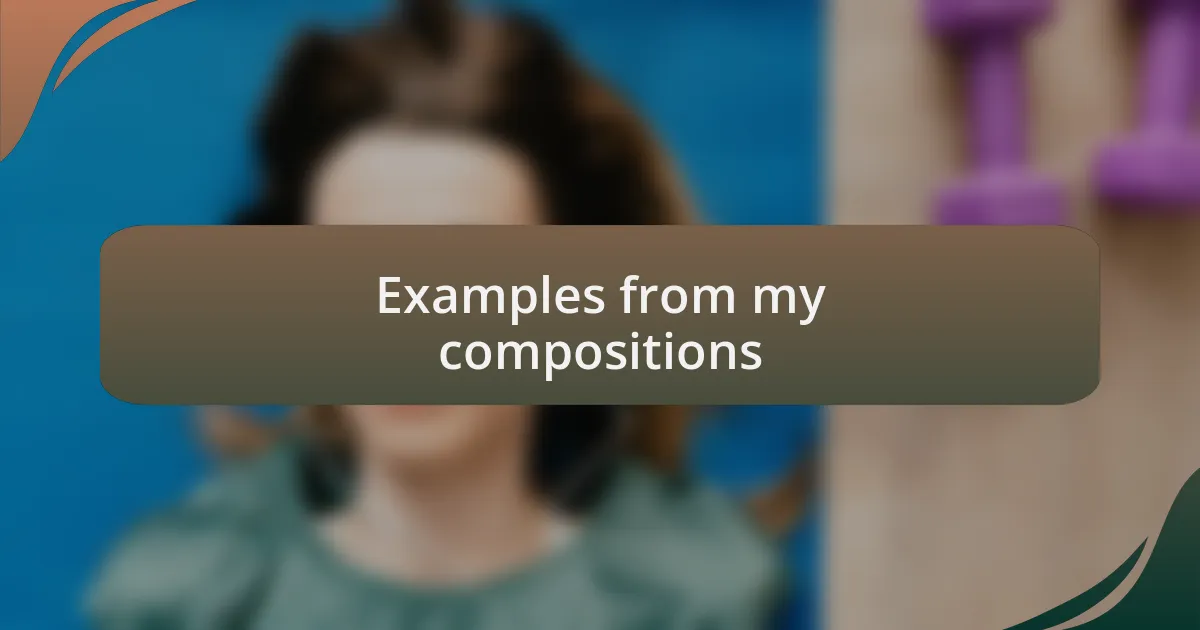Key takeaways:
- Non-harmonic tones enhance emotional depth and tension in music, making melodies more engaging.
- Types of non-harmonic tones, such as passing tones, neighbor tones, and anticipation tones, each serve unique purposes in shaping musical narratives.
- Strategic application of non-harmonic tones, including timing and layering, can significantly enrich a composition’s emotional impact.

Understanding non-harmonic tones in music
Non-harmonic tones, also known as non-chord tones, add color and depth to music, creating tension that yearns for resolution. I remember the first time I encountered a passing tone in a piece I was studying; it felt like a tiny spark, igniting my understanding of how even a single note can shape the emotional journey of a melody. Have you ever experienced that moment when a non-harmonic tone struck just the right chord, pulling you deeper into the music’s narrative?
In my compositions, I often play with types of non-harmonic tones like suspensions and appoggiaturas. These moments give the listener a pause, a feeling of anticipation that’s exhilarating. When I crafted a piece for piano, I decided to use a suspension that held over from one chord to the next—it was as if time momentarily stopped, and I could almost feel the audience hold their breath with me.
Understanding non-harmonic tones isn’t just a technical endeavor; it’s about connecting emotionally with the music you create. Think back to your favorite songs; are there moments that made you feel a rush of excitement or longing? Those are often the result of skillfully placed non-harmonic tones that evoke powerful emotions and lead to memorable musical experiences.

Importance of non-harmonic tones
Non-harmonic tones play a crucial role in conveying emotion and narrative in music. I remember when I first used an appoggiatura in a ballad I was writing; the tension it created was palpable. It was as if that single note could express more than words ever could, inviting listeners to feel the underlying heartache in the melody.
When I analyze my favorite songs, I often find non-harmonic tones to be the heartbeat of the piece. These notes introduce a sense of movement, pulling the listener through various emotional landscapes. Have you noticed how a well-timed suspension can transform a chord progression into something that feels like a gentle wave, rising and falling with every note?
In my experience, the true artistry of music often lies in these non-harmonic tones. They are not just embellishments; they serve as essential elements that shape the listener’s journey. I recall an instrumental piece I arranged—a moment of dissonance punctuated by a non-harmonic tone led to an explosion of resolution, leaving both me and the audience breathless. Isn’t it incredible how such subtle nuances can carry profound meaning?

Types of non-harmonic tones
There are several distinct types of non-harmonic tones, each with its own unique flavor and purpose in a composition. For example, take the passing tone. I often use this to create fluid transitions between notes; it acts like a bridge, smoothing out the melodic line. When I wrote my last piece, I could hear how each passing tone added a layer of connectivity, like a tight-knit conversation between musical phrases.
Another fascinating type is the neighbor tone, which I find particularly effective in creating tension and release. I remember crafting a solo where I introduced a neighbor tone just before resolving back to the main note—it felt like a playful tease, almost as if the music was winking at the listener. This type of non-harmonic tone invites curiosity, pulling the audience in and making them wonder what might come next.
Lastly, the anticipation tone has always captivated me with its ability to heighten expectation. I once incorporated anticipation tones right before a pivotal moment in a song, and the energy was electric. It’s like holding your breath just before a grand reveal—it amplifies the excitement, making the eventual resolution feel all the more satisfying. Isn’t it interesting how these non-harmonic tones, so subtle in their nature, can wield such power over the emotional flow of a piece?

Techniques for applying non-harmonic tones
When applying non-harmonic tones, I’ve found that strategic timing matters immensely. For instance, often during a climax of a melody, I’ll plant a well-placed suspension right before the resolution. I remember one performance of mine where the audience’s anticipation became palpable; you could almost feel everyone collectively holding their breath until the chord finally resolved. That suspense truly created a memorable moment in the piece.
Another technique I enjoy is layering non-harmonic tones within harmonies. By introducing a pedal tone—a sustained bass note beneath the shifting harmonies—I create an interesting contrast. Once, while experimenting with this in a piano composition, the mixture of stable and unstable tones led to an unexpected emotional depth. It felt as though I was painting a sonic landscape where each brushstroke added layers of meaning.
I’ve also found that using non-harmonic tones for rhythmic variation can energize a piece. For instance, incorporating an upbeat passing tone creates lively syncopation that grabs attention. I recall a rehearsal where this technique transformed a rather mundane section into a vibrant musical dialogue, sparking new life into the entire composition. Do you see how such small changes can energize a melody—like a sudden splash of color in an otherwise monochrome painting?

Examples from my compositions
In my recent string quartet, I employed non-harmonic tones to heighten emotional tension. When the first violin introduced a deliberate appoggiatura right before a key change, it felt like a character on stage delivering a poignant line. The room went quiet, and I could sense the audience leaning in, caught in the moment as we all faced the impending resolution together. Isn’t it fascinating how a simple note can evoke such a strong response?
I often experiment with non-harmonic tones to evoke specific atmospheres. In one composition, I used a series of neighbor tones within a woodwind arrangement, weaving in and out of the main melody. This technique created a dreamlike quality that was almost otherworldly. I felt as if I was guiding listeners through a whimsical landscape, and I could see them get lost in the sound.
Another memorable instance involved crafting a choral piece where I incorporated non-harmonic tones as a way to build a narrative. I layered some suspensions amidst harmonized vocals, reflecting moments of longing in the lyrics. Hearing the choir perform that section live was exhilarating; the tension between the voices created an emotional pull that resonated with everyone present. Have you ever felt a chill run down your spine from just a tonal shift? That’s the transformative power of non-harmonic tones in action!